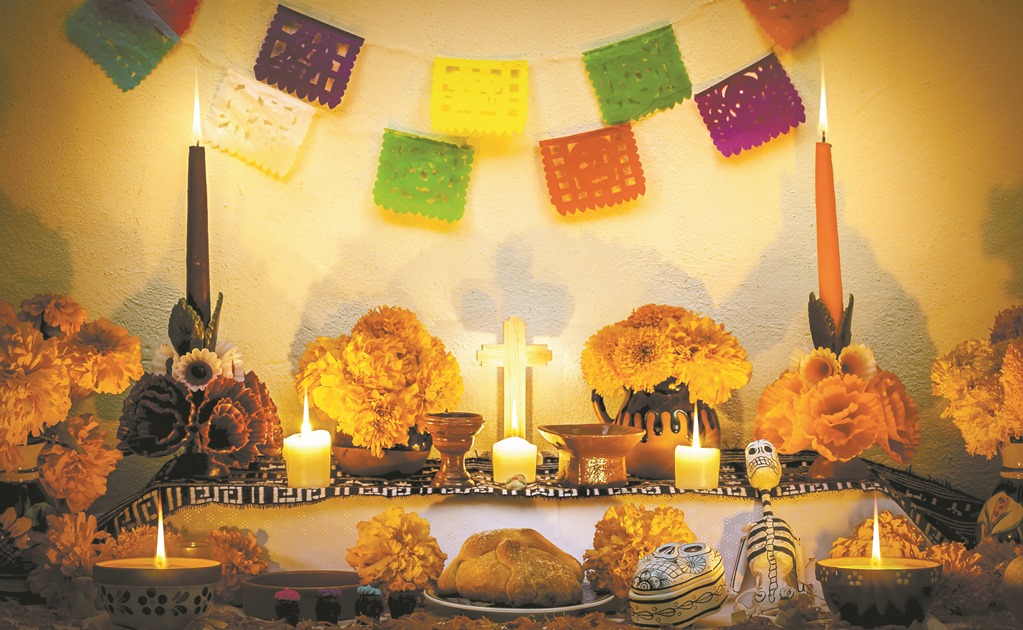

In the lobby of the Hannon Library, I displayed my shoebox altar with another student’s shoebox altar to create a more extravagant altar. Creators can even combine their shoebox altars with others to create one larger ofrenda. I strongly encourage everyone to create a shoebox altar next year to celebrate friends and family. The decoration process is up to the designer as we all create ofrendas to commemorate and remember our deceased loved ones. Some other decoration materials that could be used are papel picado (perforated paper), calaveras (skulls), ribbon, yarn, tissue paper, and construction paper. After displaying this photo in the middle of my altar, I decorated around it with a variety of items including tissue paper marigold flowers, battery-operated candles, and some of my grandfather’s favorite foods like chocolate, apples, and wine. Next, I selected and printed out a picture of a deceased loved one, who in my case was my grandfather. Participants may optionally paint their shoebox however, I chose not to as I liked the lavender color of my box.

First, I glued the side of the shoebox lid to the side of the shoebox such that the two indentations were facing the same direction. I am grateful to the Hannon Library staff, especially Ray Andrade, for providing resources and guiding me through the process of creating these altars that celebrate those who we have lost.įor those who missed the workshop on creating these altars, here are some of the steps I followed to build my shoebox altar.

From Lia Lia standing beside her shoebox altarĪlthough I am not accustomed to celebrating Día de los Muertos, having the opportunity to design a shoebox altar dedicated to my paternal grandfather was a meaningful experience that I plan to continue in years to come. Those who have passed are still a part of our everyday lives, even if we may not physically see them, so we should always keep them in our minds and hearts. I think it’s beautiful that both cultures portray death as another part of life, not something entirely separate. Like Día de los Muertos, Obon Odori is held to honor the dead as they return from the spirit realm for a night of festivities. Without them, I wouldn’t be where I am today, nor would I have been gifted with so many great opportunities in life, like the change to attend university.Īfter learning more about Día de los Muertos at the workshop, I was reminded of Obon Odori, a Japanese festival for the dead held in late summer. The workshop gave me a moment to thank my grandfathers and other late ancestors for their hard work and sacrifices. In our busy, chaotic everyday lives, it can be difficult to find a moment to relax and think about what we have. The workshop offered us a perfect moment for reflection. I also included a paper crane in my altar, both as a nod to my ethnic background and a reference to the element of air. For my altar, I tried (and failed) to create simplistic trees from green pipe cleaners to represent earth. Some people focused on creating designs with tissue paper, while others took advantage of the buttons and paper cut-outs to decorate any empty spaces in their altars. I enjoyed seeing how everyone customized their altars using the given materials. Thanks to our facilitator from Self-Help Graphics, I quickly learned that we could have artistic freedom when decorating the shoebox, as long as we included certain decorative features, like a reference to all four elements (earth, wind, fire and air). At the beginning of the workshop, I didn’t know if there was an objectively “correct” way to make an altar. Alongside my friends, I made an altar from a recycled shoebox for my maternal and paternal grandfathers. So attending the Shoebox Altar Workshop was a great cultural experience for me. While I had heard of Día de los Muertos, I had never participated in any of the practices associated with it. From Kaylee Kayle (left) with other workshop attendees
#Virtual dia de los muertos altar how to
In collaboration with Self Help Graphics, and sponsored by LMU’s Office of Diversity, Equity, and Inclusion, LMU’s Chicano Latino Student Services, the Latino Faculty Association, and the Latinx Staff Association, more than 25 in-person and virtual attendees had the opportunity to learn about the history of the holiday and how to make their own “shoebox altar.” We asked our student assistants Kaylee, Lia, and Vero to share with us their experience attending the workshop. Hannon Library hosted a workshop to celebrate Día de los Muertos.


 0 kommentar(er)
0 kommentar(er)
